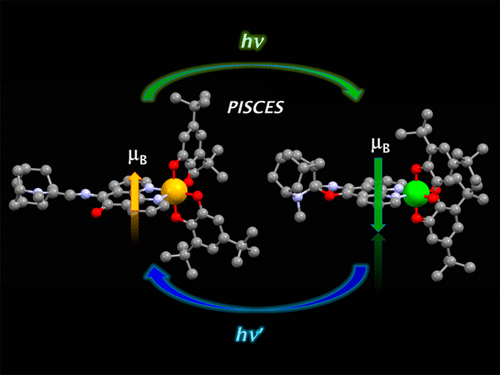当前位置:
X-MOL 学术
›
J. Am. Chem. Soc.
›
论文详情
Our official English website, www.x-mol.net, welcomes your
feedback! (Note: you will need to create a separate account there.)
Opto-Spintronics: Photoisomerization-Induced Spin State Switching at 300 K in Photochrome-Cobalt Dioxolene Thin Films
Journal of the American Chemical Society ( IF 14.4 ) Pub Date : 2018-10-10 , DOI: 10.1021/jacs.8b09190
Michelle M. Paquette 1 , Daniel Plaul 1 , Aiko Kurimoto 1 , Brian O. Patrick 2 , Natia L. Frank 1
Journal of the American Chemical Society ( IF 14.4 ) Pub Date : 2018-10-10 , DOI: 10.1021/jacs.8b09190
Michelle M. Paquette 1 , Daniel Plaul 1 , Aiko Kurimoto 1 , Brian O. Patrick 2 , Natia L. Frank 1
Affiliation

|
Controllable quantum systems are under active investigation for quantum computing, secure information processing, and nonvolatile memory. The optical manipulation of spin quantum states provides an important strategy for quantum control with both temporal and spatial resolution. Challenges in increasing the lifetime of photoinduced magnetic states at T > 200 K have hindered progress toward utilizing photomagnetic materials in quantum device architectures. Here we demonstrate reversible light-induced magnetization switching in an organic thin film at device operating temperatures of 300-330 K. By utilizing photochromic ligands that undergo structural changes in the solid state, the changes in ligand field associated with photoisomerization modulate the ligand field and in turn the oxidation and spin state of a bound metal center. Green light irradiation (λexc = 550 nm) of a spirooxazine cobalt-dioxolene complex induces photoisomerization of the ligand that in turn triggers a reversible intramolecular charge-transfer coupled spin-transition process at the cobalt center. The generation of photomagnetic states through conversion between a low-spin Co(III)-semiquinone doublet and a high-spin Co(II)-bis-semiquinone sextet state has been demonstrated in both solution and the solid state and is described as a photoisomerization-induced spin-charge excited state (PISCES) process. The high transition temperature (325 K) and long-lived photoinduced state (τ = 10 s at 300 K) are dictated by the photochromic ligand. Theory provides effective modeling of the phenomenon and long-term strategies to further modulate the lifetimes of photomagnetic states for quantum information technologies at the single molecule level.
中文翻译:

光电自旋电子学:在 300 K 光致变色钴二氧戊环薄膜中光异构化诱导的自旋状态切换
可控量子系统正在积极研究用于量子计算、安全信息处理和非易失性存储器。自旋量子态的光学操纵为具有时间和空间分辨率的量子控制提供了重要的策略。在 T > 200 K 时增加光致磁态寿命的挑战阻碍了在量子器件架构中利用光磁材料的进展。在这里,我们展示了在 300-330 K 的器件工作温度下有机薄膜中可逆的光诱导磁化转换。 通过利用在固态中发生结构变化的光致变色配体,与光异构化相关的配体场的变化调节了配体场和反过来,束缚金属中心的氧化和自旋状态。绿光照射 (λexc = 550 nm) 的螺恶嗪钴-二氧戊环复合物会诱导配体的光异构化,进而在钴中心触发可逆的分子内电荷转移耦合自旋跃迁过程。通过低自旋 Co(III)-半醌双峰和高自旋 Co(II)-双半醌六重态之间的转换产生光磁态已在溶液和固态中得到证实,并被描述为光异构化诱导自旋电荷激发态 (PISCES) 过程。高转变温度 (325 K) 和长寿命光诱导状态 (τ = 10 s 在 300 K) 由光致变色配体决定。
更新日期:2018-10-10
中文翻译:

光电自旋电子学:在 300 K 光致变色钴二氧戊环薄膜中光异构化诱导的自旋状态切换
可控量子系统正在积极研究用于量子计算、安全信息处理和非易失性存储器。自旋量子态的光学操纵为具有时间和空间分辨率的量子控制提供了重要的策略。在 T > 200 K 时增加光致磁态寿命的挑战阻碍了在量子器件架构中利用光磁材料的进展。在这里,我们展示了在 300-330 K 的器件工作温度下有机薄膜中可逆的光诱导磁化转换。 通过利用在固态中发生结构变化的光致变色配体,与光异构化相关的配体场的变化调节了配体场和反过来,束缚金属中心的氧化和自旋状态。绿光照射 (λexc = 550 nm) 的螺恶嗪钴-二氧戊环复合物会诱导配体的光异构化,进而在钴中心触发可逆的分子内电荷转移耦合自旋跃迁过程。通过低自旋 Co(III)-半醌双峰和高自旋 Co(II)-双半醌六重态之间的转换产生光磁态已在溶液和固态中得到证实,并被描述为光异构化诱导自旋电荷激发态 (PISCES) 过程。高转变温度 (325 K) 和长寿命光诱导状态 (τ = 10 s 在 300 K) 由光致变色配体决定。

































 京公网安备 11010802027423号
京公网安备 11010802027423号